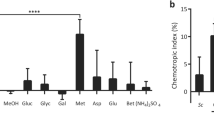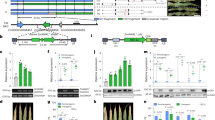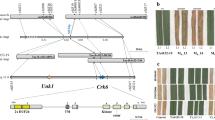Abstract
The cAMP–PKA and MAP kinase pathways are essential for plant infection in the wheat head blight fungus Fusarium graminearum. To identify upstream receptors of these well-conserved signalling pathways, we systematically characterized the 105 G-protein-coupled receptor (GPCR) genes. Although none were required for vegetative growth, five GPCR genes (GIV1–GIV5) significantly upregulated during plant infection were important for virulence. The giv1 mutant was defective in the formation of specialized infection structures known as infection cushions, which was suppressed by application of exogenous cAMP and dominant active FST7 MEK kinase. GIV1 was important for the stimulation of PKA and Gpmk1 MAP kinase by compounds in wheat spikelets. GIV2 and GIV3 were important for infectious growth after penetration. Invasive hyphae of the giv2 mutant were defective in cell-to-cell spreading and mainly grew intercellularly in rachis tissues. Interestingly, the GIV2–GIV5 genes form a phylogenetic cluster with GIV6, which had overlapping functions with GIV5 during pathogenesis. Furthermore, the GIV2–GIV6 cluster is part of a 22-member subfamily of GPCRs, with many of them having in planta-specific upregulation and a common promoter element; however, only three subfamily members are conserved in other fungi. Taken together, F. graminearum has an expanded subfamily of infection-related GPCRs for regulating various infection processes.
This is a preview of subscription content, access via your institution
Access options
Access Nature and 54 other Nature Portfolio journals
Get Nature+, our best-value online-access subscription
$29.99 / 30 days
cancel any time
Subscribe to this journal
Receive 12 digital issues and online access to articles
$119.00 per year
only $9.92 per issue
Buy this article
- Purchase on Springer Link
- Instant access to full article PDF
Prices may be subject to local taxes which are calculated during checkout





Similar content being viewed by others
Data availability
The data that support the findings of this study are available from the corresponding author and C. J. (cjiang@nwafu.edu.cn) upon request. RNA-seq data generated in this study are accessible under the accession numbers SRR8568982–SRR8568984 and SRR8569386–SRR8569394.
References
Goswami, R. S. & Kistler, H. C. Heading for disaster: Fusarium graminearum on cereal crops. Mol. Plant Pathol. 5, 515–525 (2004).
Brown, N. A., Urban, M., Van De Meene, A. M. L. & Hammond-Kosack, K. E. The infection biology of Fusarium graminearum: Defining the pathways of spikelet to spikelet colonisation in wheat ears. Fungal Biol. 114, 555–571 (2010).
Bai, G. H. & Shaner, G. Management and resistance in wheat and barley to Fusarium head blight. Annu. Rev. Phytopathol. 42, 135–161 (2004).
Strange, R., Majer, J. & Smith, H. The isolation and identification of choline and betaine as the two major components in anthers and wheat germ that stimulate Fusarium graminearum in vitro. Physiol. Plant Pathol. 4, 277–290 (1974).
Urban, M., Daniels, S., Mott, E. & Hammond-Kosack, K. Arabidopsis is susceptible to the cereal ear blight fungal pathogens Fusarium graminearum and Fusarium culmorum. Plant J. 32, 961–973 (2002).
Jiang, C., Zhang, X., Liu, H. Q. & Xu, J. R. Mitogen-activated protein kinase signaling in plant pathogenic fungi. PLoS Pathol. 14, e1006875 (2018).
Jenczmionka, N. J., Maier, F. J., Losch, A. P. & Schafer, W. Mating, conidiation and pathogenicity of Fusarium graminearum, the main causal agent of the head-blight disease of wheat, are regulated by the MAP kinase Gpmk1. Curr. Genet. 43, 87–95 (2003).
Cuzick, A., Urban, M. & Hammond-Kosack, K. Fusarium graminearum gene deletion mutants map1 and tri5 reveal similarities and differences in the pathogenicity requirements to cause disease on Arabidopsis and wheat floral tissue. New Phytol. 177, 990–1000 (2008).
Hu, S. et al. The cAMP–PKA pathway regulates growth, sexual and asexual differentiation, and pathogenesis in Fusarium graminearum. Mol. Plant Microbe Interact. 27, 557–566 (2014).
Bormann, J., Boenisch, M. J., Bruckner, E., Firat, D. & Schafer, W. The adenylyl cyclase plays a regulatory role in the morphogenetic switch from vegetative to pathogenic lifestyle of Fusarium graminearum on wheat. PLoS ONE 9, e91135 (2014).
Nguyen, T. V., Schafer, W. & Bormann, J. The stress-activated protein kinase FgOS-2 is a key regulator in the life cycle of the cereal pathogen Fusarium graminearum. Mol. Plant Microbe Interact. 25, 1142–1156 (2012).
Hou, Z. M. et al. A mitogen-activated protein kinase gene (MGV1) in Fusarium graminearum is required for female fertility, heterokaryon formation, and plant infection. Mol. Plant Microbe Interact. 15, 1119–1127 (2002).
Li, L., Wright, S. J., Krystofova, S., Park, G. & Borkovich, K. A. Heterotrimeric G protein signaling in filamentous fungi. Annu. Rev. Microbiol. 61, 423–452 (2007).
Yu, H. Y. et al. Functional analyses of heterotrimeric G protein G alpha and G beta subunits in Gibberella zeae. Microbiology 154, 392–401 (2008).
Cabrera, I. E. et al. Global analysis of predicted G protein-coupled receptor genes in the filamentous fungus, Neurospora crassa. Genes Genom. Genet. 5, 2729–2743 (2015).
Bieszke, J. A. et al. The nop-1 gene of Neurospora crassa encodes a seven transmembrane helix retinal-binding protein homologous to archaeal rhodopsins. Proc. Natl Acad. Sci. USA 96, 8034–8039 (1999).
DeZwaan, T. M., Carroll, A. M., Valent, B. & Sweigard, J. A. Magnaporthe grisea Pth11p is a novel plasma membrane protein that mediates appressorium differentiation in response to inductive substrate cues. Plant Cell 11, 2013–2030 (1999).
Kou, Y., Tan, Y. H., Ramanujam, R. & Naqvi, N. I. Structure-function analyses of the Pth11 receptor reveal an important role for CFEM motif and redox regulation in rice blast. New Phytol. 214, 330–342 (2017).
Lee, J. K., Leslie, J. F. & Bowden, R. L. Expression and function of sex pheromones and receptors in the homothallic ascomycete Gibberella zeae. Eukaryot. Cell 7, 1211–1221 (2008).
Ma, L. J. et al. Comparative genomics reveals mobile pathogenicity chromosomes in Fusarium. Nature 464, 367–373 (2010).
Cuomo, C. A. et al. The Fusarium graminearum genome reveals a link between localized polymorphism and pathogen specialization. Science 317, 1400–1402 (2007).
Brown, N. A., Schrevens, S., van Dijck, P. & Goldman, G. H. Fungal G-protein-coupled receptors: mediators of pathogenesis and targets for disease control. Nat. Microbiol. 3, 402–414 (2018).
Tucker, S. L. et al. Common genetic pathways regulate organ-specific infection-related development in the rice blast fungus. Plant Cell 22, 953–972 (2010).
Li, L. & Borkovich, K. A. GPR-4 is a predicted G-protein-coupled receptor required for carbon source-dependent asexual growth and development in Neurospora crassa. Eukaryot. Cell 5, 1287–1300 (2006).
Liu, H. Q. et al. Genome-wide A-to-I RNA editing in fungi independent of ADAR enzymes. Genome Res. 26, 499–509 (2016).
Chen, D. P. et al. Sexual specific functions of Tub1 beta-tubulins require stage-specific RNA processing and expression in Fusarium graminearum. Environ. Microbiol. 20, 4009–4021 (2018).
Boenisch, M. J. & Schafer, W. Fusarium graminearum forms mycotoxin producing infection structures on wheat. BMC Plant Biol. 11, 110 (2011).
Becker, M., Becker, Y., Green, K. & Scott, B. The endophytic symbiont Epichloe festucae establishes an epiphyllous net on the surface of Lolium perenne leaves by development of an expressorium, an appressorium-like leaf exit structure. New Phytol. 211, 240–254 (2016).
Park, A. R. et al. Functional analyses of regulators of G protein signaling in Gibberella zeae. Fungal Genet. Biol. 49, 511–520 (2012).
Miller, S. S., Chabot, D. M. P., Ouellet, T., Harris, L. J. & Fedak, G. Use of a Fusarium graminearum strain transformed with green fluorescent protein to study infection in wheat (Triticum aestivum). Can. J. Plant Pathol. 26, 453–463 (2004).
Zhang, X. W. et al. In planta stage-specific fungal gene profiling elucidates the molecular strategies of Fusarium graminearum growing inside wheat coleoptiles. Plant Cell 24, 5159–5176 (2012).
Ma, L. S. et al. The Ustilago maydis repetitive effector Rsp3 blocks the antifungal activity of mannose-binding maize proteins. Nat. Commun. 9, 1711 (2018).
Turra, D., El Ghalid, M., Rossi, F. & Di Pietro, A. Fungal pathogen uses sex pheromone receptor for chemotropic sensing of host plant signals. Nature 527, 521 (2015).
Min, K. et al. A novel gene, ROA, is required for normal morphogenesis and discharge of ascospores in Gibberella zeae. Eukaryot. Cell 9, 1495–1503 (2010).
Jiang, C. et al. TRI6 and TRI10 play different roles in the regulation of deoxynivalenol (DON) production by cAMP signalling in Fusarium graminearum. Environ. Microbiol. 18, 3689–3701 (2016).
Zhao, X. H., Kim, Y., Park, G. & Xu, J. R. A mitogen-activated protein kinase cascade regulating infection-related morphogenesis in Magnaporthe grisea. Plant Cell 17, 1317–1329 (2005).
Wang, C. F. et al. Functional analysis of the kinome of the wheat scab fungus Fusarium graminearum. PLoS Pathol. 7, e1002460 (2011).
Bruno, K. S., Tenjo, F., Li, L., Hamer, J. E. & Xu, J. R. Cellular localization and role of kinase activity of PMK1 in Magnaporthe grisea. Eukaryot. Cell 3, 1525–1532 (2004).
Raviv, Z., Kalie, E. & Seger, R. MEK5 and ERK5 are localized in the nuclei of resting as well as stimulated cells, while MEKK2 translocates from the cytosol to the nucleus upon stimulation. J. Cell Sci. 117, 1773–1784 (2004).
Wang, Q. et al. Characterization of the two-speed subgenomes of Fusarium graminearum reveals the fast-speed subgenome specialized for adaption and infection. Front. Plant Sci. 8, 140 (2017).
Son, H. et al. A phenome-based functional analysis of transcription factors in the cereal head blight fungus, Fusarium graminearum. PLoS Pathol. 7, e1002310 (2011).
Kulkarni, R. D., Thon, M. R., Pan, H. Q. & Dean, R. A. Novel G-protein-coupled receptor-like proteins in the plant pathogenic fungus Magnaporthe grisea. Genome Biol. 6, 24 (2005).
Li, G. T., Zhou, X. Y. & Xu, J. R. Genetic control of infection-related development in Magnaporthe oryzae. Curr. Opin. Microbiol. 15, 678–684 (2012).
Sakulkoo, W. et al. A single fungal MAP kinase controls plant cell-to-cell invasion by the rice blast fungus. Science 359, 1399 (2018).
Zhang, X., Liu, W. D., Li, Y., Li, G. T. & Xu, J. R. Expression of HopAI interferes with MAP kinase signalling in Magnaporthe oryzae. Environ. Microbiol. 19, 4190–4204 (2017).
Zhou, X., Li, G. & Xu, J. R. Efficient approaches for generating GFP fusion and epitope-tagging constructs in filamentous fungi. Methods Mol. Biol. 722, 199–212 (2011).
Madhani, H. D., Styles, C. A. & Fink, G. R. MAP kinases with distinct inhibitory functions impart signaling specificity during yeast differentiation. Cell 91, 673–684 (1997).
Kang, Z. S., Buchenauer, H., Huang, L. L., Han, Q. M. & Zhang, H. C. Cytological and immunocytochemical studies on responses of wheat spikes of the resistant Chinese cv. Sumai 3 and the susceptible cv. Xiaoyan 22 to infection by Fusarium graminearum. Eur. J. Plant Pathol. 120, 383–396 (2008).
Chen, X. H., Zhang, L., Zhao, J. X., Wu, J. & Liu, S. H. Study and utilize on a new wheat variety of nation approve Xiaoyan22. Chin. Agri. Sci. Bull. 9, 218–220 (2007).
Jonkers, W., Dong, Y. H., Broz, K. & Kistler, H. C. The Wor1-like protein Fgp1 regulates pathogenicity, toxin synthesis and reproduction in the phytopathogenic fungus Fusarium graminearum. PLoS Pathol. 8, e1002724 (2012).
Ding, S. L. et al. Transducin beta-like gene FTL1 Is essential for pathogenesis in Fusarium graminearum. Eukaryot. Cell 8, 867–876 (2009).
Yin, T. et al. The cyclase-associated protein FgCap1 has both protein kinase A-dependent and -independent functions during deoxynivalenol production and plant infection in Fusarium graminearum. Mol. Plant Pathol. 19, 552–563 (2018).
Ramanujam, R. & Naqvi, N. I. PdeH, a high-affinity cAMP phosphodiesterase, is a key regulator of asexual and pathogenic differentiation in Magnaporthe oryzae. PLoS Pathol. 6, e1000897 (2010).
Zhang, X., Bian, Z. & Xu, J. R. in Plant Pathogenic Fungi and Oomycetes (eds Ma, W. B. & Wolpert, T.) Ch. 8 (Springer, 2018).
Zheng, D. W. et al. The FgHOG1 pathway regulates hyphal growth, stress responses, and plant infection in Fusarium graminearum. PLoS ONE 7, e49495 (2012).
Ding, S. L. et al. The Tig1 histone deacetylase complex regulates infectious growth in the rice blast fungus Magnaporthe oryzae. Plant Cell 22, 2495–2508 (2010).
Krystofova, S. & Borkovich, K. A. The heterotrimeric G-protein subunits GNG-1 and GNB-1 form a Gbetagamma dimer required for normal female fertility, asexual development, and galpha protein levels in Neurospora crassa. Eukaryot. Cell 4, 365–378 (2005).
Kim, H. K. & Yun, S. H. Evaluation of potential reference genes for quantitative RT-PCR analysis in Fusarium graminearum under different culture conditions. Plant Pathol. J. 27, 301–309 (2011).
Wagner, G. P., Kin, K. & Lynch, V. J. Measurement of mRNA abundance using RNA-seq data: RPKM measure is inconsistent among samples. Theor. Biosci. 131, 281–285 (2012).
Cleries, R. et al. BootstRatio: A web-based statistical analysis of fold-change in qPCR and RT-qPCR data using resampling methods. Comput. Biol. Med. 42, 438–445 (2012).
Acknowledgements
We thank W. Wang, R. Hei, H. Jiang, J. Ren, P. Huang, C. Wu and C. Wang for assistance with generating GPCR gene deletion mutants. We also thank L. Dunkle and P. Goldsbrough at Purdue University for critical reading of this manuscript. This work was supported by grants from the National Natural Science Foundation of China (no. 31772114), NSWBSI, USDA NIFA (Award no. 2013-68004-20378), Tang Scholar and the Natural Science Basic Research Plan in Shaanxi Province of China (no. 2017JM3001).
Author information
Authors and Affiliations
Contributions
J.-R.X. and C.J. designed the research and wrote the paper. C.J., S.C., Z.W., H.X., J.L., G.W., M.D., C.G., C.F. and C.H. performed the experiments. C.J., H.L. and Q.W. analysed the data.
Corresponding author
Ethics declarations
Competing interests
The authors declare no competing interests.
Additional information
Publisher’s note: Springer Nature remains neutral with regard to jurisdictional claims in published maps and institutional affiliations.
Supplementary information
Supplementary Information
Supplementary Figures 1–23, Supplementary References and Supplementary Table legends.
Supplementary Data
Supplementary Tables 1–6.
Rights and permissions
About this article
Cite this article
Jiang, C., Cao, S., Wang, Z. et al. An expanded subfamily of G-protein-coupled receptor genes in Fusarium graminearum required for wheat infection. Nat Microbiol 4, 1582–1591 (2019). https://doi.org/10.1038/s41564-019-0468-8
Received:
Accepted:
Published:
Issue Date:
DOI: https://doi.org/10.1038/s41564-019-0468-8
This article is cited by
-
The nematode-trapping fungus Arthrobotrys oligospora detects prey pheromones via G protein-coupled receptors
Nature Microbiology (2024)
-
Regulation of TRI5 expression and deoxynivalenol biosynthesis by a long non-coding RNA in Fusarium graminearum
Nature Communications (2024)
-
Regulation of symbiotic interactions and primitive lichen differentiation by UMP1 MAP kinase in Umbilicaria muhlenbergii
Nature Communications (2023)
-
Herbicide 2,4-dichlorophenoxyacetic acid interferes with MAP kinase signaling in Fusarium graminearum and is inhibitory to fungal growth and pathogenesis
Stress Biology (2023)
-
Combatting Fusarium head blight: advances in molecular interactions between Fusarium graminearum and wheat
Phytopathology Research (2022)



